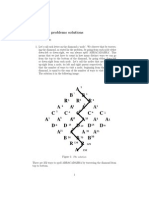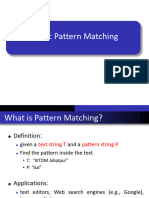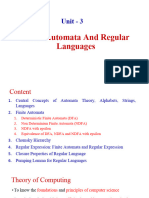String Matching With Finite Automata: by Caroline Moore
Uploaded by
shahzad5alamString Matching With Finite Automata: by Caroline Moore
Uploaded by
shahzad5alamString Matching with Finite
Automata
by Caroline Moore
String Matching
Whenever you use a search engine, or a
find function like sed or grep, you are
utilizing a string matching program. Many
of these programs create finite automata in
order to effectively search for your string.
Finite Automata
A finite automaton is a quintuple (Q, E, o, s, F):
Q: the finite set of states
E: the finite input alphabet
o: the transition function from QxE to Q
s e Q: the start state
F c Q: the set of final (accepting) states
How it works
A finite automaton accepts
strings in a specific language. It
begins in state q
0
and reads
characters one at a time from
the input string. It makes
transitions (|) based on these
characters, and if when it
reaches the end of the tape it is
in one of the accept states, that
string is accepted by the
language.
Graphic: Eppstein, David.
http://www.ics.uci.edu/~eppstein/161/9
60222.html
The Suffix Function
In order to properly
search for the string, the
program must define a
suffix function (o)
which checks to see
how much of what it is
reading matches the
search string at any
given moment.
Graphic: Reif, John.
http://www.cs.duke.edu/education/courses/c
ps130/fall98/lectures/lect14/node31.html
Example: nano
n a o other
empty: n c c c
n: n na c c
na: nan c c c
nan: n na nano c
nano: nano nano nano nano
Graphic & Example: Eppstein, David. http://www.ics.uci.edu/~eppstein/161/960222.html
String-Matching Automata
For any pattern P of length m, we can
define its string matching automata:
Q = {0,,m} (states)
q
0
= 0 (start state)
F = {m} (accepting state)
o(q,a) = o(P
q
a)
The transition function chooses the next state to
maintain the invariant:
|(T
i
) = o(T
i
)
After scanning in i characters, the state number is the
longest prefix of P that is also a suffix of T
i
.
Finite-Automaton-Matcher
The simple loop structure
implies a running time
for a string of length n is
O(n).
However: this is only the
running time for the
actual string matching. It
does not include the time
it takes to compute the
transition function.
Graphic: http://www.cs.duke.edu/education/courses/cps130/fall98/lectures/lect14/node33.html
Computing the Transition Function
Compute-Transition-Function (P,E)
m length[P]
For q 0 to m
do for each character a e E
do k min(m+1, q+2)
repeat k k-1
until P
k
P
q
a
o(q,a) k
return o
This procedure computes
o(q,a) according to its
definition. The loop on line
2 cycles through all the
states, while the nested loop
on line 3 cycles through the
alphabet. Thus all state-
character combinations are
accounted for. Lines 4-7 set
o(q,a) to be the largest k such
that P
k
P
q
a.
Running Time of
Compute-Transition-Function
Running Time: O(m
3
|E|)
Outer loop: m |E|
Inner loop: runs at most m+1
P
k
P
q
a: requires up to m comparisons
Improving Running Time
Much faster procedures for computing the transition
function exist. The time required to compute P can be
improved to O(m|E|).
The time it takes to find the string is linear: O(n).
This brings the total runtime to:
O(n + m|E|)
Not bad if your string is fairly small relative to the text
you are searching in.
Sources
Cormen, et al. Introduction to Algorithms. 1990
MIT Press, Cambridge. 862-868.
Reif, John.
http://www.cs.duke.edu/education/courses/cps130/fall
98/lectures/lect14/node28.html
Eppstein, David.
http://www.ics.uci.edu/~eppstein/161/960222.html
You might also like
- 11 Data Structures and Algorithms - Narasimha KarumanchiNo ratings yet11 Data Structures and Algorithms - Narasimha Karumanchi12 pages
- Unit8 ADA SPPDF 2022 11 11 17 17 37pdf 2023 12 06 16 57 08No ratings yetUnit8 ADA SPPDF 2022 11 11 17 17 37pdf 2023 12 06 16 57 0818 pages
- All Chapters of Automata and Complexity Theory NewNo ratings yetAll Chapters of Automata and Complexity Theory New61 pages
- Module 06. String Algorithms Lecture 1 - 2No ratings yetModule 06. String Algorithms Lecture 1 - 219 pages
- String Matching With Finite Automata and KMPNo ratings yetString Matching With Finite Automata and KMP23 pages
- This Chapter "Theory of Computation" Is Taken From OurNo ratings yetThis Chapter "Theory of Computation" Is Taken From Our51 pages
- Automata & Complexity Theory Cosc3025: Chapter OneNo ratings yetAutomata & Complexity Theory Cosc3025: Chapter One27 pages
- Theory of Computation: Course Note Prepared by Tyng-Ruey Chuang Week 8, Spring 2010No ratings yetTheory of Computation: Course Note Prepared by Tyng-Ruey Chuang Week 8, Spring 201011 pages
- Position S + 1 in Text T) If 0 S N - M and T (S + 1 - . S + M) P (1 - . M) (That Is, If T (S + J) P (J), For 1 J M) - If100% (1)Position S + 1 in Text T) If 0 S N - M and T (S + 1 - . S + M) P (1 - . M) (That Is, If T (S + J) P (J), For 1 J M) - If2 pages
- Finite Automata and Formal Language (19CS3501) : Department of Computer ScienceNo ratings yetFinite Automata and Formal Language (19CS3501) : Department of Computer Science37 pages
- CS 373: Theory of Computation: Manoj Prabhakaran Mahesh Viswanathan Fall 2008No ratings yetCS 373: Theory of Computation: Manoj Prabhakaran Mahesh Viswanathan Fall 200815 pages
- Air Conditioning Euroline Service Manual TH AW52 - 64ALNo ratings yetAir Conditioning Euroline Service Manual TH AW52 - 64AL47 pages
- Elcometer 456 MK 3 DFTG - Operating Instructions - Basic - With BluetoothNo ratings yetElcometer 456 MK 3 DFTG - Operating Instructions - Basic - With Bluetooth59 pages
- 3DOF Ball On Plate Using Closed Loop Stepper MotorNo ratings yet3DOF Ball On Plate Using Closed Loop Stepper Motor14 pages
- Bead Dealers in Chawri Bazar, Delhi, India - JustdialNo ratings yetBead Dealers in Chawri Bazar, Delhi, India - Justdial6 pages
- Precision of Intraoral Digital Dental Impressions With ITero and Extraoral Digitization With The ITero and A Model ScannerNo ratings yetPrecision of Intraoral Digital Dental Impressions With ITero and Extraoral Digitization With The ITero and A Model Scanner8 pages
- Implementation Approaches To Huffman DecodingNo ratings yetImplementation Approaches To Huffman Decoding6 pages
- 11 Data Structures and Algorithms - Narasimha Karumanchi11 Data Structures and Algorithms - Narasimha Karumanchi
- Unit8 ADA SPPDF 2022 11 11 17 17 37pdf 2023 12 06 16 57 08Unit8 ADA SPPDF 2022 11 11 17 17 37pdf 2023 12 06 16 57 08
- All Chapters of Automata and Complexity Theory NewAll Chapters of Automata and Complexity Theory New
- This Chapter "Theory of Computation" Is Taken From OurThis Chapter "Theory of Computation" Is Taken From Our
- Automata & Complexity Theory Cosc3025: Chapter OneAutomata & Complexity Theory Cosc3025: Chapter One
- Theory of Computation: Course Note Prepared by Tyng-Ruey Chuang Week 8, Spring 2010Theory of Computation: Course Note Prepared by Tyng-Ruey Chuang Week 8, Spring 2010
- Position S + 1 in Text T) If 0 S N - M and T (S + 1 - . S + M) P (1 - . M) (That Is, If T (S + J) P (J), For 1 J M) - IfPosition S + 1 in Text T) If 0 S N - M and T (S + 1 - . S + M) P (1 - . M) (That Is, If T (S + J) P (J), For 1 J M) - If
- Finite Automata and Formal Language (19CS3501) : Department of Computer ScienceFinite Automata and Formal Language (19CS3501) : Department of Computer Science
- CS 373: Theory of Computation: Manoj Prabhakaran Mahesh Viswanathan Fall 2008CS 373: Theory of Computation: Manoj Prabhakaran Mahesh Viswanathan Fall 2008
- Air Conditioning Euroline Service Manual TH AW52 - 64ALAir Conditioning Euroline Service Manual TH AW52 - 64AL
- Elcometer 456 MK 3 DFTG - Operating Instructions - Basic - With BluetoothElcometer 456 MK 3 DFTG - Operating Instructions - Basic - With Bluetooth
- 3DOF Ball On Plate Using Closed Loop Stepper Motor3DOF Ball On Plate Using Closed Loop Stepper Motor
- Bead Dealers in Chawri Bazar, Delhi, India - JustdialBead Dealers in Chawri Bazar, Delhi, India - Justdial
- Precision of Intraoral Digital Dental Impressions With ITero and Extraoral Digitization With The ITero and A Model ScannerPrecision of Intraoral Digital Dental Impressions With ITero and Extraoral Digitization With The ITero and A Model Scanner

























































































